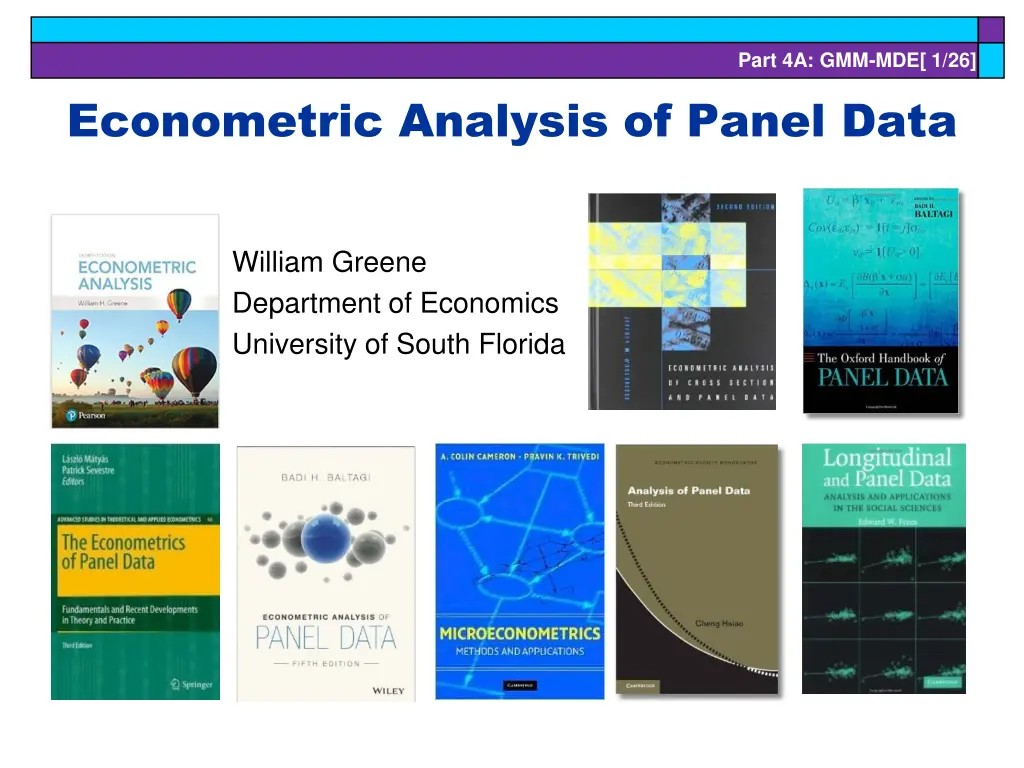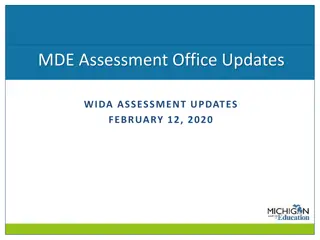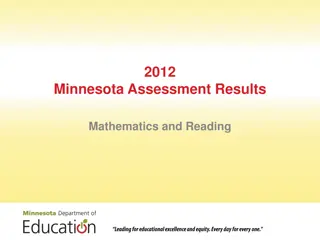
Econometric Analysis of Panel Data: GMM-MDE by William Greene
Explore Chamberlain's approach and Minimum Distance Estimation (MDE) in the field of econometric analysis of panel data as presented by William Greene from the University of South Florida. Learn about treating panels as a system of equations, SUR models, assumptions, balanced panels, and more.
Download Presentation

Please find below an Image/Link to download the presentation.
The content on the website is provided AS IS for your information and personal use only. It may not be sold, licensed, or shared on other websites without obtaining consent from the author. If you encounter any issues during the download, it is possible that the publisher has removed the file from their server.
You are allowed to download the files provided on this website for personal or commercial use, subject to the condition that they are used lawfully. All files are the property of their respective owners.
The content on the website is provided AS IS for your information and personal use only. It may not be sold, licensed, or shared on other websites without obtaining consent from the author.
E N D
Presentation Transcript
Part 4A: GMM-MDE[ 1/26] Econometric Analysis of Panel Data William Greene Department of Economics University of South Florida
Part 4A: GMM-MDE[ 2/26] Chamberlain s Approach and Minimum Distance Estimation Chamberlain (1984) Panel Data, Handbook of Econometrics Innovation: treat the panel as a system of equations: SUR Models, See Wooldridge, Ch. 7 through p. 172. Assumptions: Balanced panel Minimal restrictions on variances and covariances of disturbances (zero means, finite fourth moments) Model the correlation between effects and regressors
Part 4A: GMM-MDE[ 3/26] Chamberlain it = + = + Assuming no time invariant variables in picked up when we examine Hausman and Taylor.) Re: Mundlak's treatment = + + i t 1 it i w Not a regression. Changes with next period's data. Viewed as the of on (1, projection x + + y y x X , each observation , T observations for individual i it i it i i i i i X . (To be i , E( | X ) 0. i i T x = t i1 i2 iT = x , x ,..., x ) . i i
Part 4A: GMM-MDE[ 4/26] Chamberlain - Data Period Period t= 1 2 ... T 1 2 ... T Individual i=1 y y ... y Individual 21 22 i=2 y y ... y ... ... ... Individual i=N y y ... y = i T variables = NxT matrix = N x TK matrix Y 11 21 12 22 1T 2T x x x x x ... ... x 11 12 1T 2T N1 = i = TK variables X N2 NT x x x x K variables ... x N1 N2 NT y y it it
Part 4A: GMM-MDE[ 5/26] Chamberlain Model it = + = + = + + = + THIS IS T SEEMINGLY UNRELATED REGRESSION EQUATIONS y v Equation uses year 1 data, N observations y v Each equation has y for that ye x ... the x's from all years. There is a constant term y v plus TxK variables in each equation. x + = it is = y y = x , E[ x | x ] 0, E[ | x ] unrestricted it i it it i i ts is T s 1 + w = i s i is it T s 1 x + + + x x x w = i 2 w it s it i 2 w + is an unrestricted TxT covariance matrix. = = v , E[v | ] 0, E[v v | x ] + still unrestricted t it it i it is i ts I i = + = + i + + x i1 1 i1 ar regressed on i2 2 i2 i = + + iT T iT
Part 4A: GMM-MDE[ 6/26] Chamberlain SUR Model The SUR system y y y ... i = + = + = + i + + + x x x v , v ..., Arranged in a row now v i1 i 1 i1 i2 2 i2 iT T iT ..,N, ... ... i + (y y ... y ) = (1, ) x (v v ... v ) i1 i2 iT i1 i2 iT 1 2 T i i i , E[ 0 + y E[ = (1, ) | v x x = , by rows, i = 1,. v = i i i | ] v v x ] i i
Part 4A: GMM-MDE[ 7/26] Chamberlain Implied Model Col 1 2 3 ... T Constant, 1 row (t 1), K rows (t 2), K rows (t 3), K rows ... (t T), ... + + = = = + + ... ... = + + + + = ... K rows
Part 4A: GMM-MDE[ 8/26] Chamberlain Estimation of FGLS. Use the usual two step GLS estimator. OLS. System has an unrestricted covariance matrix and the same regressors in every equation. GLS = FGLS = equation by equation OLS. Denote the T OLS coefficient vectors as P = [p1, p2, p3 , pT]. Unconstrained OLS will be consistent. Plim pt= t, t=1, ,T OLS is inefficient. There are T(T-1) different estimates of in P and T-1 estimates of each t. = + + + + ... ... ... ... 0 0 0 0 + + + + ...
Part 4A: GMM-MDE[ 9/26] Chamberlain Estimation of Regardless of how the columns of are estimated, the estimator of will be computed using sums of squares and cross products of residuals from the T equations: i i x N = ts (1/N) (y x )(y x ) = i 1 it t is s N =(1/N) ( y x )( y ) = i 1 Y - X i i i i = (1/N)[ ] [ ' Y - X ] The problem to be solved is how to estimate .
Part 4A: GMM-MDE[ 10/26] Chamberlain Estimator: Application Cornwell and Rupert: Lwageit = i + 1Expit + 2Expit2 + 3Wksit + it i projected onto all 7 periods of Exp, Exp2 and Wks. For each of the 7 years, we regress Lwageit on a constant and the three variables for all 7 years. Each regression has 22 coefficients.
Part 4A: GMM-MDE[ 11/26] Chamberlain Approach Least Squares Estimates 1976 1977 1978 1979 1980 1981 1982 What They Estimate + 0 0 0 0 0 0 0 1 1 1 1 1 1 1 + + 2 2 2 2 2 2 2 + + 3 3 3 3 3 3 3 + + 4 4 4 4 4 4 4 + + 5 5 5 5 5 5 5 + + 6 6 6 6 6 6 6 + + 7 7 7 7 7 7 7 There are 7 estimates of There are potentially 42 estimates of There are potentially 6 estimates of each t. How do we average the different estimates to get a single estimate?
Part 4A: GMM-MDE[ 12/26] Efficient Estimation of Minimum Distance Estimation: Chamberlain (1984). (See Wooldridge, pp. 545-547.) Asymptotically efficient Assumes only finite fourth moments of vit Maximum likelihood Estimation: Joreskog (1981), Greene (1981,2008) Add normality assumption Same asymptotic properties as MDE (!)
Part 4A: GMM-MDE[ 13/26] MDE-1 Cornwell and Rupert. Pooled, all 7 years +--------+--------------+----------------+--------+--------+----------+ |Variable| Coefficient | Standard Error |b/St.Er.|P[|Z|>z]| Mean of X| +--------+--------------+----------------+--------+--------+----------+ Constant| 5.25112359 .07128679 73.662 .0000 EXP | .04010465 .00215918 18.574 .0000 19.8537815 EXPSQ | -.00067338 .474431D-04 -14.193 .0000 514.405042 WKS | .00421609 .00108137 3.899 .0001 46.8115246 OCC | -.14000934 .01465670 -9.553 .0000 .51116447 IND | .04678864 .01179350 3.967 .0001 .39543818 SOUTH | -.05563737 .01252710 -4.441 .0000 .29027611 SMSA | .15166712 .01206870 12.567 .0000 .65378151 MS | .04844851 .02056867 2.355 .0185 .81440576 FEM | -.36778522 .02509705 -14.655 .0000 .11260504 UNION | .09262675 .01279951 7.237 .0000 .36398559 ED | .05670421 .00261283 21.702 .0000 12.8453782
Part 4A: GMM-MDE[ 14/26] MDE-2 Cornwell and Rupert. Year 1 +--------+--------------+----------------+--------+--------+----------+ |Variable| Coefficient | Standard Error |b/St.Er.|P[|Z|>z]| Mean of X| +--------+--------------+----------------+--------+--------+----------+ Constant| 5.11054693 .13191639 38.741 .0000 EXP | .03199044 .00426736 7.497 .0000 16.8537815 EXPSQ | -.00057556 .00010715 -5.372 .0000 400.282353 WKS | .00516535 .00183814 2.810 .0050 46.2806723 OCC | -.11540477 .02987160 -3.863 .0001 .52436975 IND | .01473703 .02447046 .602 .5470 .39159664 SOUTH | -.05868033 .02588364 -2.267 .0234 .29243697 SMSA | .18340943 .02526029 7.261 .0000 .66050420 MS | .07416736 .04493028 1.651 .0988 .82352941 FEM | -.30678002 .05378268 -5.704 .0000 .11260504 UNION | .11046575 .02637235 4.189 .0000 .36134454 ED | .04757357 .00539679 8.815 .0000 12.8453782
Part 4A: GMM-MDE[ 15/26] MDE-3 Cornwell and Rupert. Year 7 +--------+--------------+----------------+--------+--------+----------+ |Variable| Coefficient | Standard Error |b/St.Er.|P[|Z|>z]| Mean of X| +--------+--------------+----------------+--------+--------+----------+ Constant| 5.59009297 .19011263 29.404 .0000 EXP | .02938018 .00652410 4.503 .0000 22.8537815 EXPSQ | -.00048597 .00012680 -3.833 .0001 638.527731 WKS | .00341276 .00267762 1.275 .2025 46.4521008 OCC | -.16152170 .03690729 -4.376 .0000 .51260504 IND | .08466281 .02916370 2.903 .0037 .40504202 SOUTH | -.05876312 .03090689 -1.901 .0573 .29243697 SMSA | .16619142 .02955099 5.624 .0000 .64201681 MS | .09523724 .04892770 1.946 .0516 .80504202 FEM | -.32455710 .06072947 -5.344 .0000 .11260504 UNION | .10627809 .03167547 3.355 .0008 .36638655 ED | .05719350 .00659101 8.678 .0000 12.8453782
Part 4A: GMM-MDE[ 16/26] MDE-4 How to combine two estimates of Year 1: .04757357 = b [Consistent] Year 7: .05719350 = b [Consistent] Minimize: ( ? ED 1 7 2 2 2 ) + ( ) = + b b (.04757357 ) 1 ED 7 ED ED 2 (.05719350 = 7 1-w ) ED b b b b 1 ED 1 ED -1 Equivalent to minimizing I 7 ED 7 ED = Solution: w b +w b , w =1/2, w ED 1 1 7 7 1 1
Part 4A: GMM-MDE[ 17/26] MDE-5 ED How to combine two estimates of Year 1: .04757357 = b , standard error = .00539679 = s [Consistent] Year 7: .05719350 = b , standard error = .00659101 = s [Consistent] ? 1 1 7 7 2 2 b b Minimize variance weig hted: + 1 ED 7 ED . .00539679 .00659101 1 b b b b 2 1 s 0 0 s 1 ED 1 ED Equivalent to min: 2 7 1/s 7 ED 7 ED 2 1 = = = Solution: w b + w b w w 1-w , , ED 1 1 7 7 1 7 1 2 1 2 7 1/s +1/s
Part 4A: GMM-MDE[ 18/26] MDE-6 Seemingly Unrelated Regressions Model lnWage = x (Year 1 regression) lnWage = x (Year 7 regression) Same in both regressions. Asy.Var[b ]= X X Asy.Cov[b 17 ( 7 b i,7 + + i,1 i,1 ,1 i i,7 ,7 i t 1 , t = 1 and 7 X X ( = ) X X t tt ] t 1 1 7 1 1 X X , ) ( )( ) 1 1 7 7
Part 4A: GMM-MDE[ 19/26] MDE-7 S11 S21 S12 S22
Part 4A: GMM-MDE[ 20/26] MDE-8 ED How to combine two estimates of Year 1: .04757357 = b Year 7: .05719350 = b Minimize variance and covariance weighted from SUR model: ? 1 7 1 b b b b .0000291254 .0000189242 .000018 .0000434414 9242 1 ED 1 ED Equivalent to min: 7 ED 7 ED + s 11 17 s s = = = Solution: w b +w b w w 1-w , , ED 1 1 7 7 1 7 1 + + 11 17 77 s s 2 1 s s s s 11 17 s s s s 11 17 = 17 77 17 77
Part 4A: GMM-MDE[ 21/26] MDE-9 b b Two coefficient estimators, the same parameter vector, . How to combine? Use a minimum distance estimator: b W W be used as long as the matrix is positive definite. and . Both estimate 1 7 1 b W W W b b 1 11 17 1 Minimize 7 17 77 7 Any may
Part 4A: GMM-MDE[ 22/26] Carey Hospital Cost Model
Part 4A: GMM-MDE[ 23/26] Multiple Estimates (25) of 10 Structural Parameters
Part 4A: GMM-MDE[ 27/26] Appendix I. Chamberlain Model Algebra
Part 4A: GMM-MDE[ 28/26] Minimum Distance Estimation Minimum Distance Estimation = stacked OLS estimates. Each subvector = [(a , , ,,..., = column 1 of P column 2 of column T of No restrictions were imposed on the T K = stacked true parameters from the matrix. = {[ ,( + ) , ,..., ],[ , = column 1 of column 2 of column T of The Minimum Distance Estimator (MDE) seeks the (T+1)K (i.e., , ,..., ) , , that are closest to the T K+T elements of . p p p p is Kx1. ),...,(a , s,t 1,1 1,2 1,T 2,1 2,2 2,T T,1 T,2 T,T p p p ),(a , p , p ,,..., P p , p ,,..., P p )] 01 02 0T 2 + T elements of . p 1 ) ,..., T 1 2 ) ] ,( + ],...,[ , , ,...,( + 0 1 2 T 0 2 0 T + 1 values for 2 0 1 2 T
Part 4A: GMM-MDE[ 29/26] MDE (2) 1 1 = Asy.Var[ p ] (1/N) estimated with (1/N) and = (1/N) G = = ( X'X /N) xx 1 1 Let = (1/N) MDE is found by minimizing with respect to ( [ ( ,..., )] p , , subject to all the restrictions. (There are T K (This is not GMM.) After estimation, is recomputed. (1) Least squares is least squares. (2) The X'X , , ,..., ( /N) xx ,..., ) 1 2 T -1 G [ p ( , , )] 1 2 T 1 2 T K(T 2 + 1).) will be larger than restrictions increase MD . MD OLS the size of the variance matrix. Larger means is - . OLS 1 = nonnegative definite. Est.Asy.Var[ ] ( X'X ) . MD MD
Part 4A: GMM-MDE[ 30/26] MDE (3) Obtaining the asymptotic covariance matrix for the MDE = {[( + ) , ,..., ],[ = T K functions of the parameters = , ,..., = K(T+1) actu , D X'X D 2 T 1 ) ,..., T 1 2 ) ] ,( + ],...,[ , ,...,( + 1 2 T 2 1 2 T al parameters 2 D = = T K x K(T+1) matrix of derivatives, all 1s and 0s. -1 -1 Est.Asy.Var[ ]=[ ( ) ]
Part 4A: GMM-MDE[ 31/26] Maximum Likelihood Estimation Maximum Likelihood Estimation assuming normality , ~ N[ , ] (1/N) (y )(y = = x i i i = y x v v 0 i i i N i 1 ) as estimated. = [ x ) ts it t is s given ( , ]. t s ts -1 log likelihood = logL=-(NT/2)[log2 + log| | + Proof in Greene (pp. 347-349). logL ( ) (no surprise) so the ML solution for = trace( )]. -1 -1 - is , as might be expected, whatever the solution for is.
Part 4A: GMM-MDE[ 32/26] MLE (2) Inserting the solution for back in the log likelihood produces the concentrated log likelihood function (NT /2)[T = + + logL which is only a function of ,that is and . The function to minimized is just (1/2)log covariance matrix for the MLE is identical to that for the MDE. log2 log | | ] c be | |. The estimator of the asymptotic
Part 4A: GMM-MDE[ 33/26] Rearrange the Panel Data i2 i1 i2 iT y y x x 1 1 x x x x ... ... x x v v i1 i1 i1 i2 iT 0 i1 i2 1 i2 = + (T rows) 2 iT i1 i2 iT y x 1 x x ... x v iT iT T K 1 K K [(K+1)T + 1 columns)] K
Part 4A: GMM-MDE[ 34/26] Generalized Regression Model i 0 i 0 i 0 i = + = = y X v , E[ v | X ] 0 , E[ v v | X ] i i i i 0 1 y X v 1 1 = + 0 N y X v N N 0 0 0 0 0 0 0 = = = y X +v , E[ | v X ] 0 , E[ vv | X ] 0 0
Part 4A: GMM-MDE[ 35/26] Least Squares i i N 0 0 i 1 N 0 = b [(1/N) X X ] (1/N) X y = i 1 = i 1 i -1 i i N i=1 0 0 i N i=1 0 plim = +plim (1/N) b X X plim (1/N) X v i -1 i i N i=1 0 0 i = +plim (1/N) X X [ ] 0 1 1 i i i N 0 0 i N 0 0 i N 0 0 i X X X X X X 1 N = Asy.Var[ | b X ] = i 1 = i 1 = i 1 N N N Asymptotics are standard for OLS in a GR model. (Text, Sec. 7.3)
Part 4A: GMM-MDE[ 36/26] GLS and FGLS 1 i i N i 1 = 0 -1 0 i N i 1 = 0 -1 X X X y = i N N (See Wooldridge, Section 7.4 for properties.) FGLS ) N i=1 0 i 0 i ( y X )( y X = Use OLS residuals: i OLS N i OLS










